Business in Emerging Markets: A Case Study of L'Oreal in India
VerifiedAdded on 2023/04/21
|21
|5772
|449
Case Study
AI Summary
This case study explores L’Oreal's business strategies in India, a fast-growing emerging market, focusing on opportunities for growth and increased market share. It investigates the strategies adopted by L’Oreal for expanding its business in India, evaluates growth opportunities in emerging markets, and provides recommendations to enhance L’Oreal’s market presence. The study highlights the significance of investing in emerging markets, emphasizing the need for multinational companies to understand cultural and economic differences to maximize returns. It examines L’Oreal's approach to adapting its products, pricing, and marketing policies to suit the Indian market, contributing insights into business growth opportunities in emerging economies and aiding similar businesses in making informed decisions and strategies.

Running head: BUSINESS IN EMERGING MARKET
Business in Emerging Market
Name of the Student:
Name of the University:
Author note:
Business in Emerging Market
Name of the Student:
Name of the University:
Author note:
Paraphrase This Document
Need a fresh take? Get an instant paraphrase of this document with our AI Paraphraser
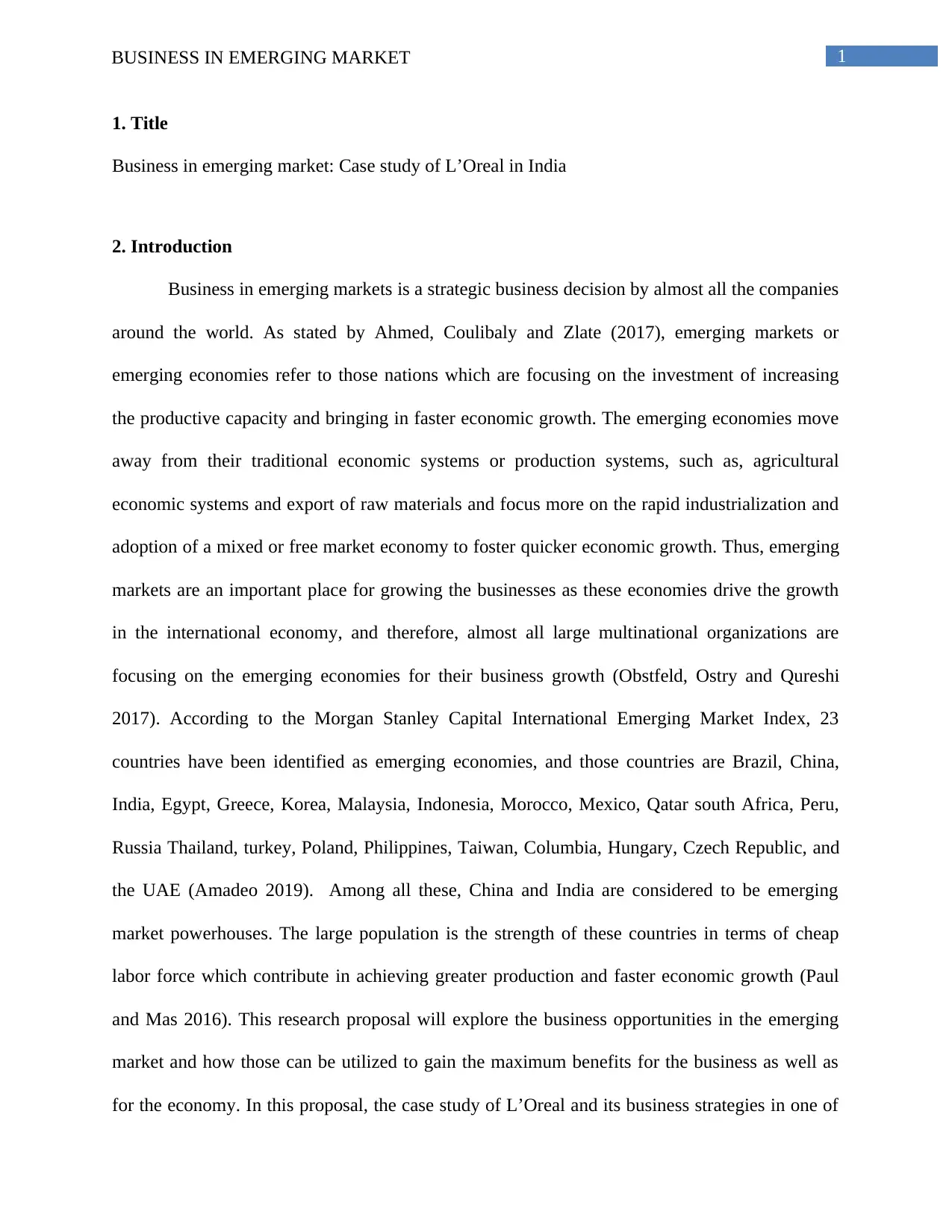
1BUSINESS IN EMERGING MARKET
1. Title
Business in emerging market: Case study of L’Oreal in India
2. Introduction
Business in emerging markets is a strategic business decision by almost all the companies
around the world. As stated by Ahmed, Coulibaly and Zlate (2017), emerging markets or
emerging economies refer to those nations which are focusing on the investment of increasing
the productive capacity and bringing in faster economic growth. The emerging economies move
away from their traditional economic systems or production systems, such as, agricultural
economic systems and export of raw materials and focus more on the rapid industrialization and
adoption of a mixed or free market economy to foster quicker economic growth. Thus, emerging
markets are an important place for growing the businesses as these economies drive the growth
in the international economy, and therefore, almost all large multinational organizations are
focusing on the emerging economies for their business growth (Obstfeld, Ostry and Qureshi
2017). According to the Morgan Stanley Capital International Emerging Market Index, 23
countries have been identified as emerging economies, and those countries are Brazil, China,
India, Egypt, Greece, Korea, Malaysia, Indonesia, Morocco, Mexico, Qatar south Africa, Peru,
Russia Thailand, turkey, Poland, Philippines, Taiwan, Columbia, Hungary, Czech Republic, and
the UAE (Amadeo 2019). Among all these, China and India are considered to be emerging
market powerhouses. The large population is the strength of these countries in terms of cheap
labor force which contribute in achieving greater production and faster economic growth (Paul
and Mas 2016). This research proposal will explore the business opportunities in the emerging
market and how those can be utilized to gain the maximum benefits for the business as well as
for the economy. In this proposal, the case study of L’Oreal and its business strategies in one of
1. Title
Business in emerging market: Case study of L’Oreal in India
2. Introduction
Business in emerging markets is a strategic business decision by almost all the companies
around the world. As stated by Ahmed, Coulibaly and Zlate (2017), emerging markets or
emerging economies refer to those nations which are focusing on the investment of increasing
the productive capacity and bringing in faster economic growth. The emerging economies move
away from their traditional economic systems or production systems, such as, agricultural
economic systems and export of raw materials and focus more on the rapid industrialization and
adoption of a mixed or free market economy to foster quicker economic growth. Thus, emerging
markets are an important place for growing the businesses as these economies drive the growth
in the international economy, and therefore, almost all large multinational organizations are
focusing on the emerging economies for their business growth (Obstfeld, Ostry and Qureshi
2017). According to the Morgan Stanley Capital International Emerging Market Index, 23
countries have been identified as emerging economies, and those countries are Brazil, China,
India, Egypt, Greece, Korea, Malaysia, Indonesia, Morocco, Mexico, Qatar south Africa, Peru,
Russia Thailand, turkey, Poland, Philippines, Taiwan, Columbia, Hungary, Czech Republic, and
the UAE (Amadeo 2019). Among all these, China and India are considered to be emerging
market powerhouses. The large population is the strength of these countries in terms of cheap
labor force which contribute in achieving greater production and faster economic growth (Paul
and Mas 2016). This research proposal will explore the business opportunities in the emerging
market and how those can be utilized to gain the maximum benefits for the business as well as
for the economy. In this proposal, the case study of L’Oreal and its business strategies in one of

2BUSINESS IN EMERGING MARKET
the fastest growing emerging economies, that is, India will be evaluated and the trends and future
directions will be addressed to recommend long run perspectives for the growth of the company.
2.1 Research aim and objectives
The aim of this research study is explore the opportunities for growth for L’Oreal, a
leading cosmetics and personal care products brand, in India, which is a fast growing emerging
market and have plenty of opportunities for business growth. The study will also recommend
ways for L’Oreal to capture a larger market share in India to maintain its position as a market
leader in the cosmetics and personal care products industry.
The research objectives are:
To explore the business strategies adopted by L’Oreal for expanding business in India
To evaluate the growth opportunities in the emerging markets
To provide appropriate recommendations to increase the market share of L’Oreal in India
2.2 Research questions
1) What are the business and marketing strategies taken by L’Oreal to make a sustainable
business in a fast growing emerging market like India?
2) What are the opportunities for business growth in India, which is an emerging economy?
3) How the business performance of L’Oreal can be improved for a larger market share in
India?
2.3 Company background
L’Oreal S.A. is one of the largest cosmetics and personal care companies in the world. It
is headquartered in Clichy, Hauts-de-Seine, a suburb near Paris, and has a registered office in
Paris. The company has products under skin care, make up, perfume, sun protection, hair color
the fastest growing emerging economies, that is, India will be evaluated and the trends and future
directions will be addressed to recommend long run perspectives for the growth of the company.
2.1 Research aim and objectives
The aim of this research study is explore the opportunities for growth for L’Oreal, a
leading cosmetics and personal care products brand, in India, which is a fast growing emerging
market and have plenty of opportunities for business growth. The study will also recommend
ways for L’Oreal to capture a larger market share in India to maintain its position as a market
leader in the cosmetics and personal care products industry.
The research objectives are:
To explore the business strategies adopted by L’Oreal for expanding business in India
To evaluate the growth opportunities in the emerging markets
To provide appropriate recommendations to increase the market share of L’Oreal in India
2.2 Research questions
1) What are the business and marketing strategies taken by L’Oreal to make a sustainable
business in a fast growing emerging market like India?
2) What are the opportunities for business growth in India, which is an emerging economy?
3) How the business performance of L’Oreal can be improved for a larger market share in
India?
2.3 Company background
L’Oreal S.A. is one of the largest cosmetics and personal care companies in the world. It
is headquartered in Clichy, Hauts-de-Seine, a suburb near Paris, and has a registered office in
Paris. The company has products under skin care, make up, perfume, sun protection, hair color
⊘ This is a preview!⊘
Do you want full access?
Subscribe today to unlock all pages.

Trusted by 1+ million students worldwide

3BUSINESS IN EMERGING MARKET
and hair care. L’Oreal S. A. was established in 1909 and currently it operates in almost all the
major countries in the world. The company claims to provide a combination of latest technology
in providing the highest quality of personal care products to the customers, especially women of
all age groups. In the first quarter of 2019, the company has experienced a surge in its revenue
earned from all the operating zones. It increased from €6778.6 million in first quarter of 2018 to
€7550.5 million in the first quarter of 2019 (Loreal-finance.com 2019). It is seen from the
financial report of the company that among the different geographic regions, highest amount of
revenue was earned from Asia Pacific region. The revenue increased from €1838.5 million to
€2398 million in the Asia Pacific region with a reported growth rate of 11.4% (Loreal-
finance.com 2019). L’Oreal has been operating in India since the last 18 years and still
considered as a young player in the cosmetics industry. The company has been able to capture a
sustainable position in the market through low prices, which was possible due to local raw
materials supply and local manufacturing process.
2.4 Justification for choosing L’Oreal and India
L’Oreal S.A. is one of the leading cosmetics and personal care brands in the world. With
the amount of capital available, the company can expand its business globally. The company is
continuously increasing its product portfolio and as per the tastes, preferences and needs of the
customers of different cultures, L’Oreal improvises its products. It also collaborates with local
designers and celebrities to increase its credibility in the respective countries. India, being one of
the largest emerging economies, has provided a great market expansion opportunity to L’Oreal.
The economy has a huge population, creating a large market potential for L’Oreal. India’s
economy is growing at a rapid rate. Along with that, the cosmetic market of India has not been
tapped to its full potential. The level of beauty, make up and personal care awareness and
and hair care. L’Oreal S. A. was established in 1909 and currently it operates in almost all the
major countries in the world. The company claims to provide a combination of latest technology
in providing the highest quality of personal care products to the customers, especially women of
all age groups. In the first quarter of 2019, the company has experienced a surge in its revenue
earned from all the operating zones. It increased from €6778.6 million in first quarter of 2018 to
€7550.5 million in the first quarter of 2019 (Loreal-finance.com 2019). It is seen from the
financial report of the company that among the different geographic regions, highest amount of
revenue was earned from Asia Pacific region. The revenue increased from €1838.5 million to
€2398 million in the Asia Pacific region with a reported growth rate of 11.4% (Loreal-
finance.com 2019). L’Oreal has been operating in India since the last 18 years and still
considered as a young player in the cosmetics industry. The company has been able to capture a
sustainable position in the market through low prices, which was possible due to local raw
materials supply and local manufacturing process.
2.4 Justification for choosing L’Oreal and India
L’Oreal S.A. is one of the leading cosmetics and personal care brands in the world. With
the amount of capital available, the company can expand its business globally. The company is
continuously increasing its product portfolio and as per the tastes, preferences and needs of the
customers of different cultures, L’Oreal improvises its products. It also collaborates with local
designers and celebrities to increase its credibility in the respective countries. India, being one of
the largest emerging economies, has provided a great market expansion opportunity to L’Oreal.
The economy has a huge population, creating a large market potential for L’Oreal. India’s
economy is growing at a rapid rate. Along with that, the cosmetic market of India has not been
tapped to its full potential. The level of beauty, make up and personal care awareness and
Paraphrase This Document
Need a fresh take? Get an instant paraphrase of this document with our AI Paraphraser

4BUSINESS IN EMERGING MARKET
knowledge is also increasing due to the availability of smart technology to the mass
(L’Oreal.com 2016). Hence, L’Oreal has been chosen as the case study organization, which is
eyeing the growing market of India to improve its business performance and profit level.
2.5 Significance of the research
Investing in the emerging markets is a conscious business decision by the multinational
companies as there are many advantages in making investments in the emerging markets. There
are high growth rates which the companies want to utilize to bring in more business growth.
However, as there are cultural as well as economic differences in the different countries, the
companies must make business decisions to incorporate the specific aspects of the economies to
get the maximum return from investment in the emerging economy. This research study will help
to investigate the business strategies and marketing strategies taken by L’Oreal while investing
and expanding its business in India. It will also explore the growth opportunities in an emerging
economy with a large number of population and economic growth rate. Based on the findings,
new measures and strategies will be suggested which could help L’Oreal to increase its market
share in India. Thus, this study will contribute in the academic world by providing in-sights
about the business growth opportunities in an emerging economy, with a focus on India and it
will also help the business and similar businesses, that invest a large amount in an emerging
market, to make decisions and strategies to utilize the potential of the emerging economies in the
maximum manner. Hence, there are twofold implications of this study, which will benefit both
the literature section as well as the multinational organizations, which invest in the emerging
economies to achieve faster growth.
knowledge is also increasing due to the availability of smart technology to the mass
(L’Oreal.com 2016). Hence, L’Oreal has been chosen as the case study organization, which is
eyeing the growing market of India to improve its business performance and profit level.
2.5 Significance of the research
Investing in the emerging markets is a conscious business decision by the multinational
companies as there are many advantages in making investments in the emerging markets. There
are high growth rates which the companies want to utilize to bring in more business growth.
However, as there are cultural as well as economic differences in the different countries, the
companies must make business decisions to incorporate the specific aspects of the economies to
get the maximum return from investment in the emerging economy. This research study will help
to investigate the business strategies and marketing strategies taken by L’Oreal while investing
and expanding its business in India. It will also explore the growth opportunities in an emerging
economy with a large number of population and economic growth rate. Based on the findings,
new measures and strategies will be suggested which could help L’Oreal to increase its market
share in India. Thus, this study will contribute in the academic world by providing in-sights
about the business growth opportunities in an emerging economy, with a focus on India and it
will also help the business and similar businesses, that invest a large amount in an emerging
market, to make decisions and strategies to utilize the potential of the emerging economies in the
maximum manner. Hence, there are twofold implications of this study, which will benefit both
the literature section as well as the multinational organizations, which invest in the emerging
economies to achieve faster growth.
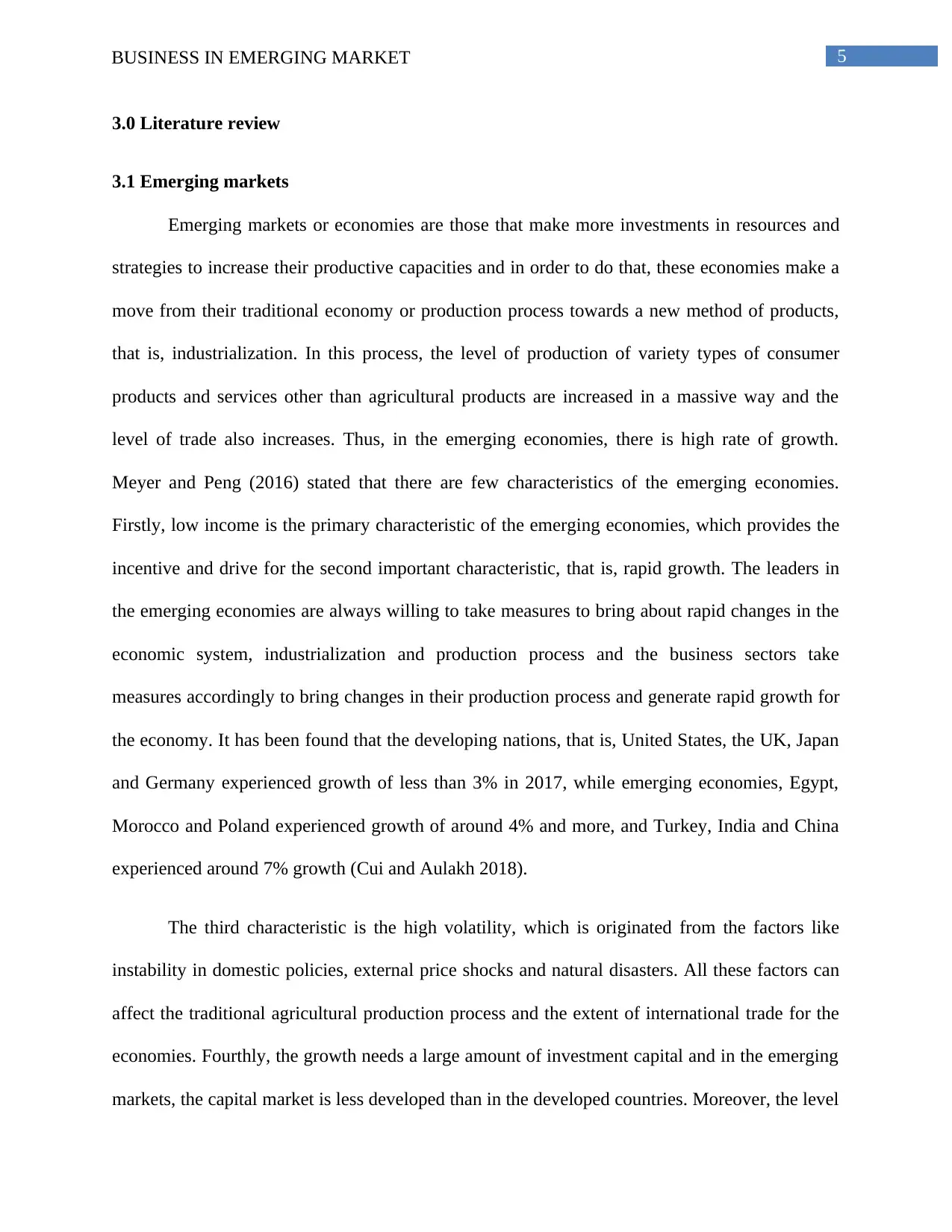
5BUSINESS IN EMERGING MARKET
3.0 Literature review
3.1 Emerging markets
Emerging markets or economies are those that make more investments in resources and
strategies to increase their productive capacities and in order to do that, these economies make a
move from their traditional economy or production process towards a new method of products,
that is, industrialization. In this process, the level of production of variety types of consumer
products and services other than agricultural products are increased in a massive way and the
level of trade also increases. Thus, in the emerging economies, there is high rate of growth.
Meyer and Peng (2016) stated that there are few characteristics of the emerging economies.
Firstly, low income is the primary characteristic of the emerging economies, which provides the
incentive and drive for the second important characteristic, that is, rapid growth. The leaders in
the emerging economies are always willing to take measures to bring about rapid changes in the
economic system, industrialization and production process and the business sectors take
measures accordingly to bring changes in their production process and generate rapid growth for
the economy. It has been found that the developing nations, that is, United States, the UK, Japan
and Germany experienced growth of less than 3% in 2017, while emerging economies, Egypt,
Morocco and Poland experienced growth of around 4% and more, and Turkey, India and China
experienced around 7% growth (Cui and Aulakh 2018).
The third characteristic is the high volatility, which is originated from the factors like
instability in domestic policies, external price shocks and natural disasters. All these factors can
affect the traditional agricultural production process and the extent of international trade for the
economies. Fourthly, the growth needs a large amount of investment capital and in the emerging
markets, the capital market is less developed than in the developed countries. Moreover, the level
3.0 Literature review
3.1 Emerging markets
Emerging markets or economies are those that make more investments in resources and
strategies to increase their productive capacities and in order to do that, these economies make a
move from their traditional economy or production process towards a new method of products,
that is, industrialization. In this process, the level of production of variety types of consumer
products and services other than agricultural products are increased in a massive way and the
level of trade also increases. Thus, in the emerging economies, there is high rate of growth.
Meyer and Peng (2016) stated that there are few characteristics of the emerging economies.
Firstly, low income is the primary characteristic of the emerging economies, which provides the
incentive and drive for the second important characteristic, that is, rapid growth. The leaders in
the emerging economies are always willing to take measures to bring about rapid changes in the
economic system, industrialization and production process and the business sectors take
measures accordingly to bring changes in their production process and generate rapid growth for
the economy. It has been found that the developing nations, that is, United States, the UK, Japan
and Germany experienced growth of less than 3% in 2017, while emerging economies, Egypt,
Morocco and Poland experienced growth of around 4% and more, and Turkey, India and China
experienced around 7% growth (Cui and Aulakh 2018).
The third characteristic is the high volatility, which is originated from the factors like
instability in domestic policies, external price shocks and natural disasters. All these factors can
affect the traditional agricultural production process and the extent of international trade for the
economies. Fourthly, the growth needs a large amount of investment capital and in the emerging
markets, the capital market is less developed than in the developed countries. Moreover, the level
⊘ This is a preview!⊘
Do you want full access?
Subscribe today to unlock all pages.

Trusted by 1+ million students worldwide
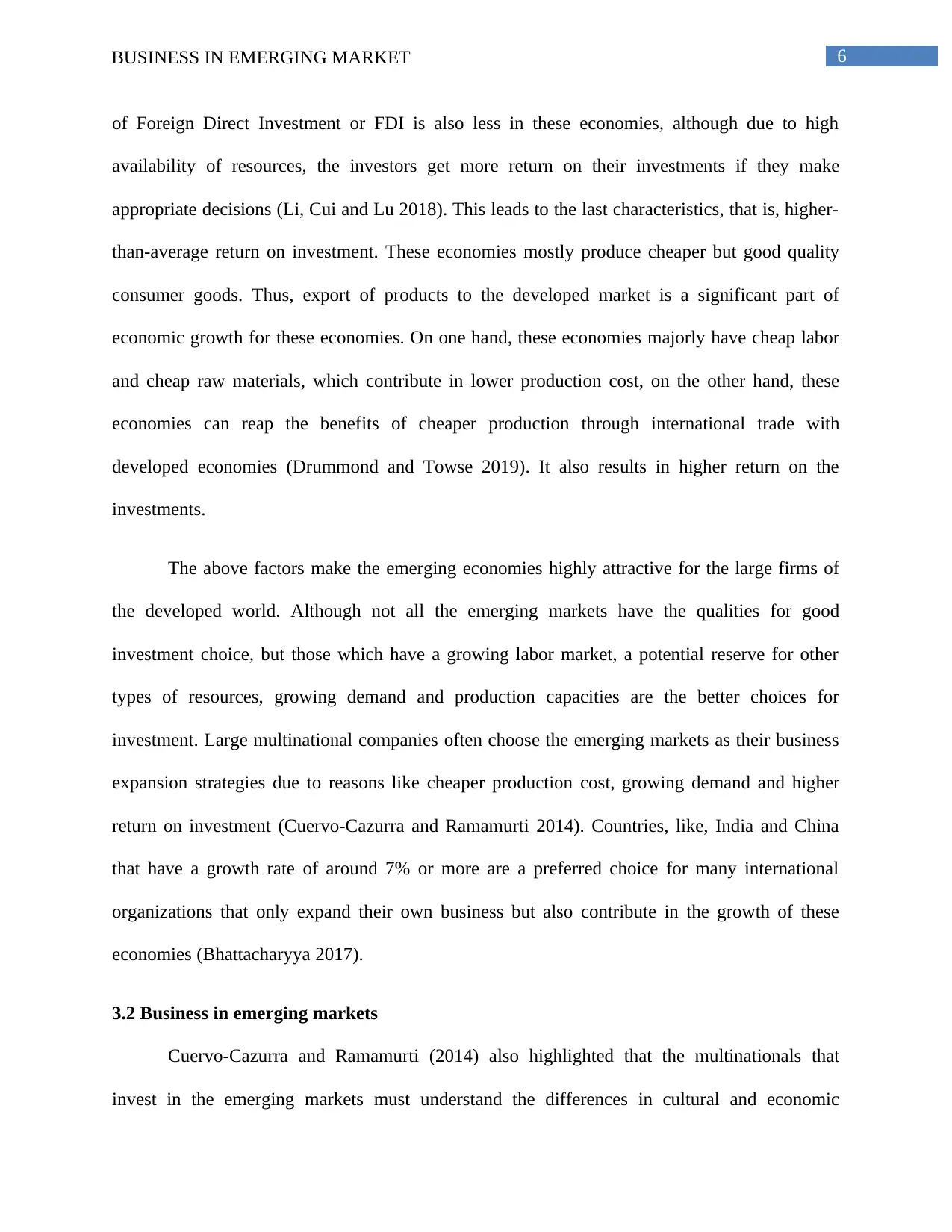
6BUSINESS IN EMERGING MARKET
of Foreign Direct Investment or FDI is also less in these economies, although due to high
availability of resources, the investors get more return on their investments if they make
appropriate decisions (Li, Cui and Lu 2018). This leads to the last characteristics, that is, higher-
than-average return on investment. These economies mostly produce cheaper but good quality
consumer goods. Thus, export of products to the developed market is a significant part of
economic growth for these economies. On one hand, these economies majorly have cheap labor
and cheap raw materials, which contribute in lower production cost, on the other hand, these
economies can reap the benefits of cheaper production through international trade with
developed economies (Drummond and Towse 2019). It also results in higher return on the
investments.
The above factors make the emerging economies highly attractive for the large firms of
the developed world. Although not all the emerging markets have the qualities for good
investment choice, but those which have a growing labor market, a potential reserve for other
types of resources, growing demand and production capacities are the better choices for
investment. Large multinational companies often choose the emerging markets as their business
expansion strategies due to reasons like cheaper production cost, growing demand and higher
return on investment (Cuervo-Cazurra and Ramamurti 2014). Countries, like, India and China
that have a growth rate of around 7% or more are a preferred choice for many international
organizations that only expand their own business but also contribute in the growth of these
economies (Bhattacharyya 2017).
3.2 Business in emerging markets
Cuervo-Cazurra and Ramamurti (2014) also highlighted that the multinationals that
invest in the emerging markets must understand the differences in cultural and economic
of Foreign Direct Investment or FDI is also less in these economies, although due to high
availability of resources, the investors get more return on their investments if they make
appropriate decisions (Li, Cui and Lu 2018). This leads to the last characteristics, that is, higher-
than-average return on investment. These economies mostly produce cheaper but good quality
consumer goods. Thus, export of products to the developed market is a significant part of
economic growth for these economies. On one hand, these economies majorly have cheap labor
and cheap raw materials, which contribute in lower production cost, on the other hand, these
economies can reap the benefits of cheaper production through international trade with
developed economies (Drummond and Towse 2019). It also results in higher return on the
investments.
The above factors make the emerging economies highly attractive for the large firms of
the developed world. Although not all the emerging markets have the qualities for good
investment choice, but those which have a growing labor market, a potential reserve for other
types of resources, growing demand and production capacities are the better choices for
investment. Large multinational companies often choose the emerging markets as their business
expansion strategies due to reasons like cheaper production cost, growing demand and higher
return on investment (Cuervo-Cazurra and Ramamurti 2014). Countries, like, India and China
that have a growth rate of around 7% or more are a preferred choice for many international
organizations that only expand their own business but also contribute in the growth of these
economies (Bhattacharyya 2017).
3.2 Business in emerging markets
Cuervo-Cazurra and Ramamurti (2014) also highlighted that the multinationals that
invest in the emerging markets must understand the differences in cultural and economic
Paraphrase This Document
Need a fresh take? Get an instant paraphrase of this document with our AI Paraphraser
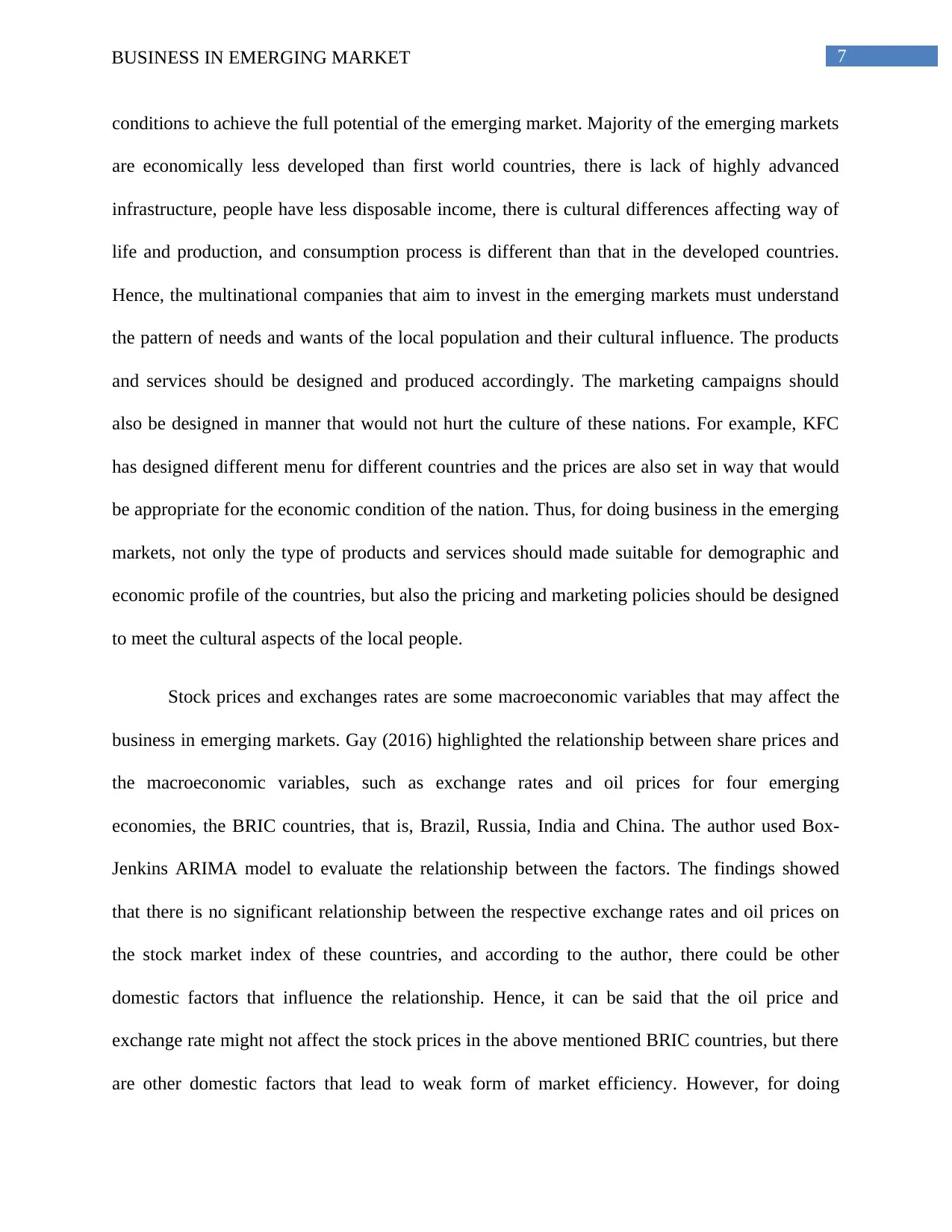
7BUSINESS IN EMERGING MARKET
conditions to achieve the full potential of the emerging market. Majority of the emerging markets
are economically less developed than first world countries, there is lack of highly advanced
infrastructure, people have less disposable income, there is cultural differences affecting way of
life and production, and consumption process is different than that in the developed countries.
Hence, the multinational companies that aim to invest in the emerging markets must understand
the pattern of needs and wants of the local population and their cultural influence. The products
and services should be designed and produced accordingly. The marketing campaigns should
also be designed in manner that would not hurt the culture of these nations. For example, KFC
has designed different menu for different countries and the prices are also set in way that would
be appropriate for the economic condition of the nation. Thus, for doing business in the emerging
markets, not only the type of products and services should made suitable for demographic and
economic profile of the countries, but also the pricing and marketing policies should be designed
to meet the cultural aspects of the local people.
Stock prices and exchanges rates are some macroeconomic variables that may affect the
business in emerging markets. Gay (2016) highlighted the relationship between share prices and
the macroeconomic variables, such as exchange rates and oil prices for four emerging
economies, the BRIC countries, that is, Brazil, Russia, India and China. The author used Box-
Jenkins ARIMA model to evaluate the relationship between the factors. The findings showed
that there is no significant relationship between the respective exchange rates and oil prices on
the stock market index of these countries, and according to the author, there could be other
domestic factors that influence the relationship. Hence, it can be said that the oil price and
exchange rate might not affect the stock prices in the above mentioned BRIC countries, but there
are other domestic factors that lead to weak form of market efficiency. However, for doing
conditions to achieve the full potential of the emerging market. Majority of the emerging markets
are economically less developed than first world countries, there is lack of highly advanced
infrastructure, people have less disposable income, there is cultural differences affecting way of
life and production, and consumption process is different than that in the developed countries.
Hence, the multinational companies that aim to invest in the emerging markets must understand
the pattern of needs and wants of the local population and their cultural influence. The products
and services should be designed and produced accordingly. The marketing campaigns should
also be designed in manner that would not hurt the culture of these nations. For example, KFC
has designed different menu for different countries and the prices are also set in way that would
be appropriate for the economic condition of the nation. Thus, for doing business in the emerging
markets, not only the type of products and services should made suitable for demographic and
economic profile of the countries, but also the pricing and marketing policies should be designed
to meet the cultural aspects of the local people.
Stock prices and exchanges rates are some macroeconomic variables that may affect the
business in emerging markets. Gay (2016) highlighted the relationship between share prices and
the macroeconomic variables, such as exchange rates and oil prices for four emerging
economies, the BRIC countries, that is, Brazil, Russia, India and China. The author used Box-
Jenkins ARIMA model to evaluate the relationship between the factors. The findings showed
that there is no significant relationship between the respective exchange rates and oil prices on
the stock market index of these countries, and according to the author, there could be other
domestic factors that influence the relationship. Hence, it can be said that the oil price and
exchange rate might not affect the stock prices in the above mentioned BRIC countries, but there
are other domestic factors that lead to weak form of market efficiency. However, for doing
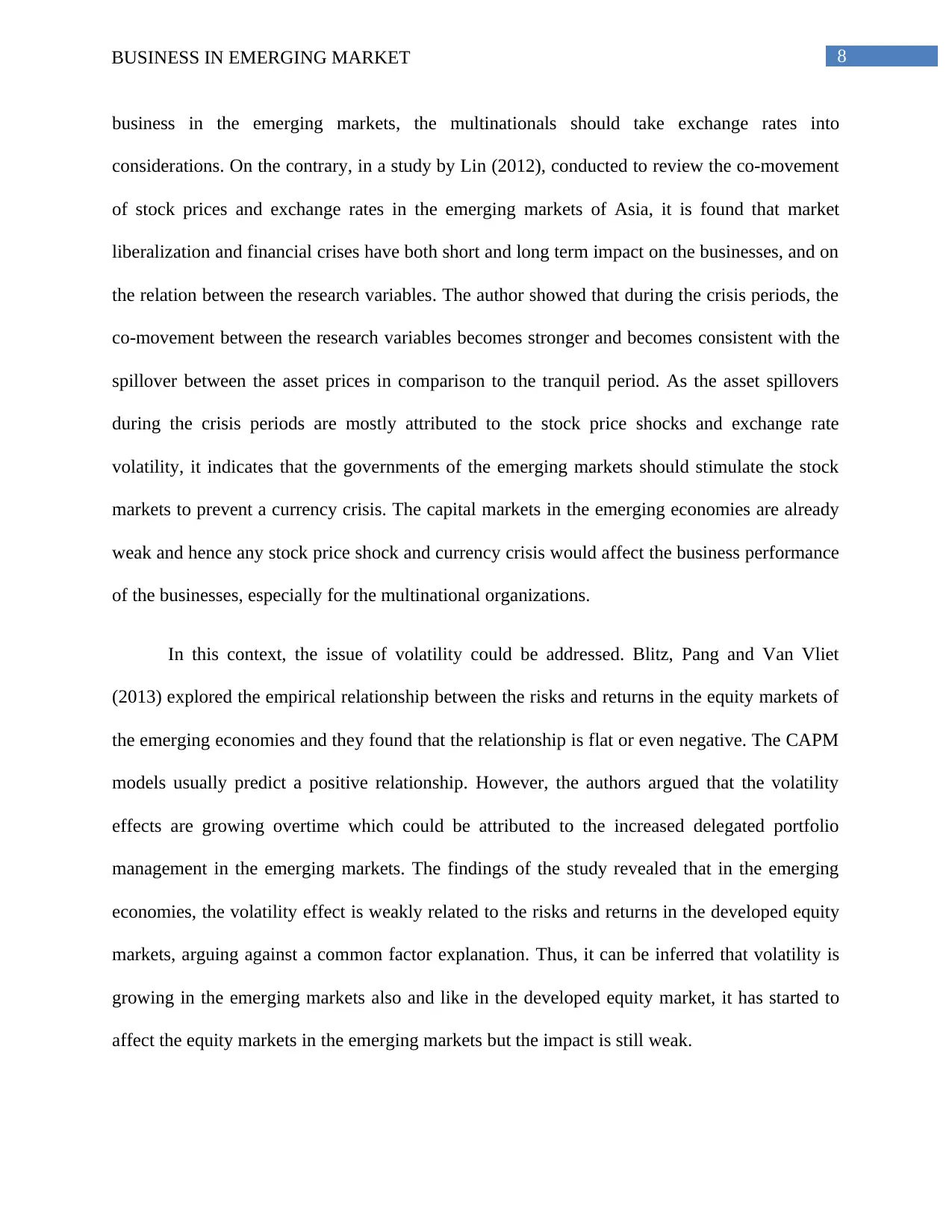
8BUSINESS IN EMERGING MARKET
business in the emerging markets, the multinationals should take exchange rates into
considerations. On the contrary, in a study by Lin (2012), conducted to review the co-movement
of stock prices and exchange rates in the emerging markets of Asia, it is found that market
liberalization and financial crises have both short and long term impact on the businesses, and on
the relation between the research variables. The author showed that during the crisis periods, the
co-movement between the research variables becomes stronger and becomes consistent with the
spillover between the asset prices in comparison to the tranquil period. As the asset spillovers
during the crisis periods are mostly attributed to the stock price shocks and exchange rate
volatility, it indicates that the governments of the emerging markets should stimulate the stock
markets to prevent a currency crisis. The capital markets in the emerging economies are already
weak and hence any stock price shock and currency crisis would affect the business performance
of the businesses, especially for the multinational organizations.
In this context, the issue of volatility could be addressed. Blitz, Pang and Van Vliet
(2013) explored the empirical relationship between the risks and returns in the equity markets of
the emerging economies and they found that the relationship is flat or even negative. The CAPM
models usually predict a positive relationship. However, the authors argued that the volatility
effects are growing overtime which could be attributed to the increased delegated portfolio
management in the emerging markets. The findings of the study revealed that in the emerging
economies, the volatility effect is weakly related to the risks and returns in the developed equity
markets, arguing against a common factor explanation. Thus, it can be inferred that volatility is
growing in the emerging markets also and like in the developed equity market, it has started to
affect the equity markets in the emerging markets but the impact is still weak.
business in the emerging markets, the multinationals should take exchange rates into
considerations. On the contrary, in a study by Lin (2012), conducted to review the co-movement
of stock prices and exchange rates in the emerging markets of Asia, it is found that market
liberalization and financial crises have both short and long term impact on the businesses, and on
the relation between the research variables. The author showed that during the crisis periods, the
co-movement between the research variables becomes stronger and becomes consistent with the
spillover between the asset prices in comparison to the tranquil period. As the asset spillovers
during the crisis periods are mostly attributed to the stock price shocks and exchange rate
volatility, it indicates that the governments of the emerging markets should stimulate the stock
markets to prevent a currency crisis. The capital markets in the emerging economies are already
weak and hence any stock price shock and currency crisis would affect the business performance
of the businesses, especially for the multinational organizations.
In this context, the issue of volatility could be addressed. Blitz, Pang and Van Vliet
(2013) explored the empirical relationship between the risks and returns in the equity markets of
the emerging economies and they found that the relationship is flat or even negative. The CAPM
models usually predict a positive relationship. However, the authors argued that the volatility
effects are growing overtime which could be attributed to the increased delegated portfolio
management in the emerging markets. The findings of the study revealed that in the emerging
economies, the volatility effect is weakly related to the risks and returns in the developed equity
markets, arguing against a common factor explanation. Thus, it can be inferred that volatility is
growing in the emerging markets also and like in the developed equity market, it has started to
affect the equity markets in the emerging markets but the impact is still weak.
⊘ This is a preview!⊘
Do you want full access?
Subscribe today to unlock all pages.

Trusted by 1+ million students worldwide
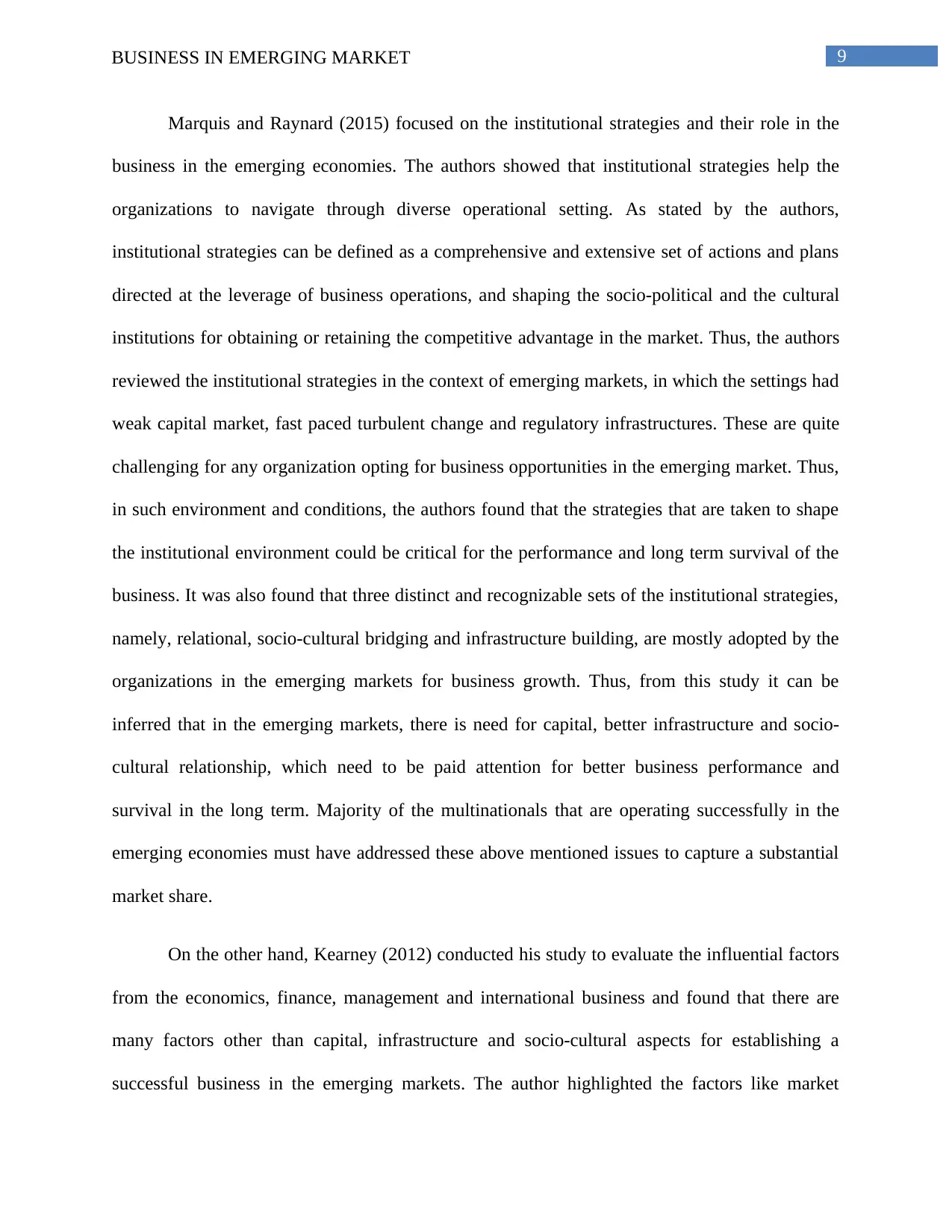
9BUSINESS IN EMERGING MARKET
Marquis and Raynard (2015) focused on the institutional strategies and their role in the
business in the emerging economies. The authors showed that institutional strategies help the
organizations to navigate through diverse operational setting. As stated by the authors,
institutional strategies can be defined as a comprehensive and extensive set of actions and plans
directed at the leverage of business operations, and shaping the socio-political and the cultural
institutions for obtaining or retaining the competitive advantage in the market. Thus, the authors
reviewed the institutional strategies in the context of emerging markets, in which the settings had
weak capital market, fast paced turbulent change and regulatory infrastructures. These are quite
challenging for any organization opting for business opportunities in the emerging market. Thus,
in such environment and conditions, the authors found that the strategies that are taken to shape
the institutional environment could be critical for the performance and long term survival of the
business. It was also found that three distinct and recognizable sets of the institutional strategies,
namely, relational, socio-cultural bridging and infrastructure building, are mostly adopted by the
organizations in the emerging markets for business growth. Thus, from this study it can be
inferred that in the emerging markets, there is need for capital, better infrastructure and socio-
cultural relationship, which need to be paid attention for better business performance and
survival in the long term. Majority of the multinationals that are operating successfully in the
emerging economies must have addressed these above mentioned issues to capture a substantial
market share.
On the other hand, Kearney (2012) conducted his study to evaluate the influential factors
from the economics, finance, management and international business and found that there are
many factors other than capital, infrastructure and socio-cultural aspects for establishing a
successful business in the emerging markets. The author highlighted the factors like market
Marquis and Raynard (2015) focused on the institutional strategies and their role in the
business in the emerging economies. The authors showed that institutional strategies help the
organizations to navigate through diverse operational setting. As stated by the authors,
institutional strategies can be defined as a comprehensive and extensive set of actions and plans
directed at the leverage of business operations, and shaping the socio-political and the cultural
institutions for obtaining or retaining the competitive advantage in the market. Thus, the authors
reviewed the institutional strategies in the context of emerging markets, in which the settings had
weak capital market, fast paced turbulent change and regulatory infrastructures. These are quite
challenging for any organization opting for business opportunities in the emerging market. Thus,
in such environment and conditions, the authors found that the strategies that are taken to shape
the institutional environment could be critical for the performance and long term survival of the
business. It was also found that three distinct and recognizable sets of the institutional strategies,
namely, relational, socio-cultural bridging and infrastructure building, are mostly adopted by the
organizations in the emerging markets for business growth. Thus, from this study it can be
inferred that in the emerging markets, there is need for capital, better infrastructure and socio-
cultural relationship, which need to be paid attention for better business performance and
survival in the long term. Majority of the multinationals that are operating successfully in the
emerging economies must have addressed these above mentioned issues to capture a substantial
market share.
On the other hand, Kearney (2012) conducted his study to evaluate the influential factors
from the economics, finance, management and international business and found that there are
many factors other than capital, infrastructure and socio-cultural aspects for establishing a
successful business in the emerging markets. The author highlighted the factors like market
Paraphrase This Document
Need a fresh take? Get an instant paraphrase of this document with our AI Paraphraser
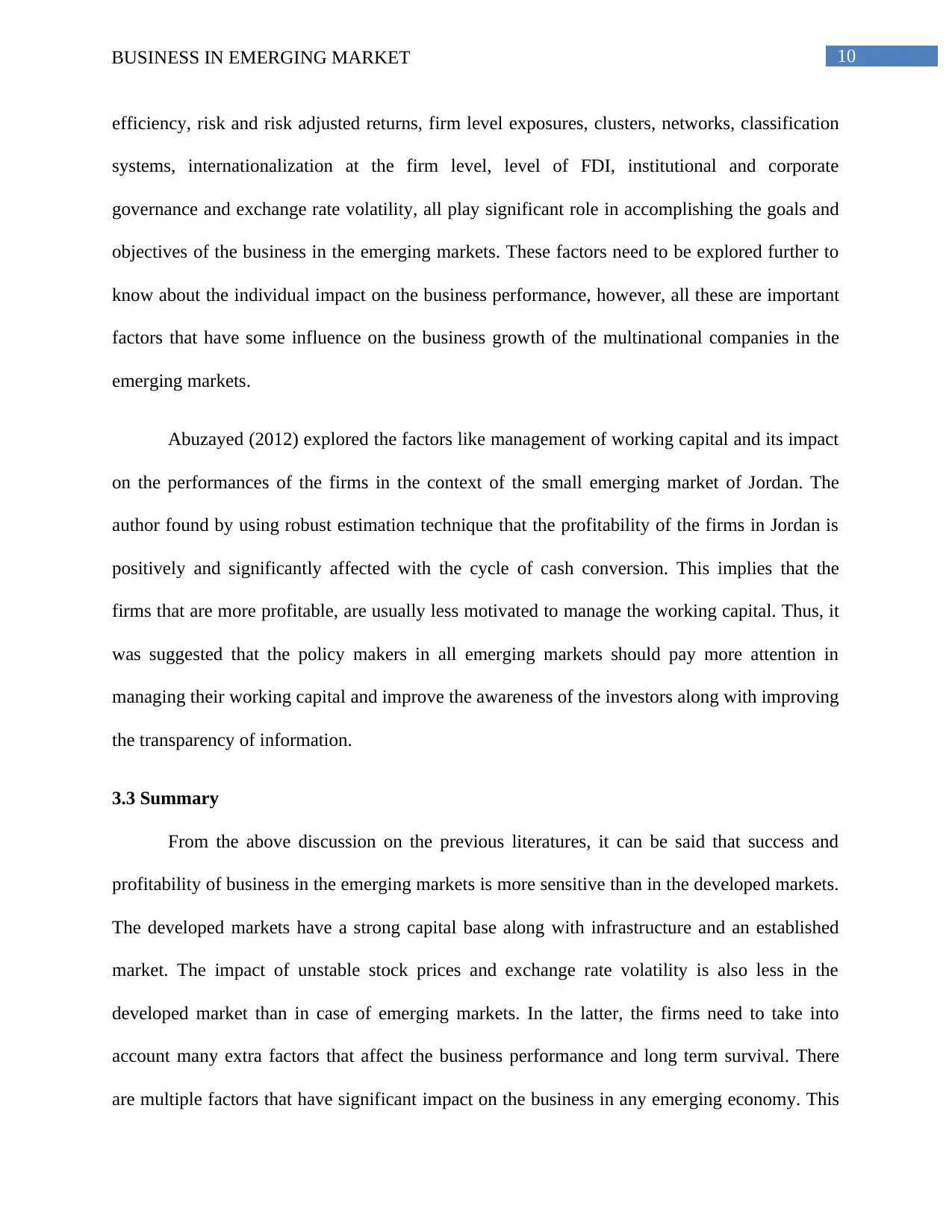
10BUSINESS IN EMERGING MARKET
efficiency, risk and risk adjusted returns, firm level exposures, clusters, networks, classification
systems, internationalization at the firm level, level of FDI, institutional and corporate
governance and exchange rate volatility, all play significant role in accomplishing the goals and
objectives of the business in the emerging markets. These factors need to be explored further to
know about the individual impact on the business performance, however, all these are important
factors that have some influence on the business growth of the multinational companies in the
emerging markets.
Abuzayed (2012) explored the factors like management of working capital and its impact
on the performances of the firms in the context of the small emerging market of Jordan. The
author found by using robust estimation technique that the profitability of the firms in Jordan is
positively and significantly affected with the cycle of cash conversion. This implies that the
firms that are more profitable, are usually less motivated to manage the working capital. Thus, it
was suggested that the policy makers in all emerging markets should pay more attention in
managing their working capital and improve the awareness of the investors along with improving
the transparency of information.
3.3 Summary
From the above discussion on the previous literatures, it can be said that success and
profitability of business in the emerging markets is more sensitive than in the developed markets.
The developed markets have a strong capital base along with infrastructure and an established
market. The impact of unstable stock prices and exchange rate volatility is also less in the
developed market than in case of emerging markets. In the latter, the firms need to take into
account many extra factors that affect the business performance and long term survival. There
are multiple factors that have significant impact on the business in any emerging economy. This
efficiency, risk and risk adjusted returns, firm level exposures, clusters, networks, classification
systems, internationalization at the firm level, level of FDI, institutional and corporate
governance and exchange rate volatility, all play significant role in accomplishing the goals and
objectives of the business in the emerging markets. These factors need to be explored further to
know about the individual impact on the business performance, however, all these are important
factors that have some influence on the business growth of the multinational companies in the
emerging markets.
Abuzayed (2012) explored the factors like management of working capital and its impact
on the performances of the firms in the context of the small emerging market of Jordan. The
author found by using robust estimation technique that the profitability of the firms in Jordan is
positively and significantly affected with the cycle of cash conversion. This implies that the
firms that are more profitable, are usually less motivated to manage the working capital. Thus, it
was suggested that the policy makers in all emerging markets should pay more attention in
managing their working capital and improve the awareness of the investors along with improving
the transparency of information.
3.3 Summary
From the above discussion on the previous literatures, it can be said that success and
profitability of business in the emerging markets is more sensitive than in the developed markets.
The developed markets have a strong capital base along with infrastructure and an established
market. The impact of unstable stock prices and exchange rate volatility is also less in the
developed market than in case of emerging markets. In the latter, the firms need to take into
account many extra factors that affect the business performance and long term survival. There
are multiple factors that have significant impact on the business in any emerging economy. This
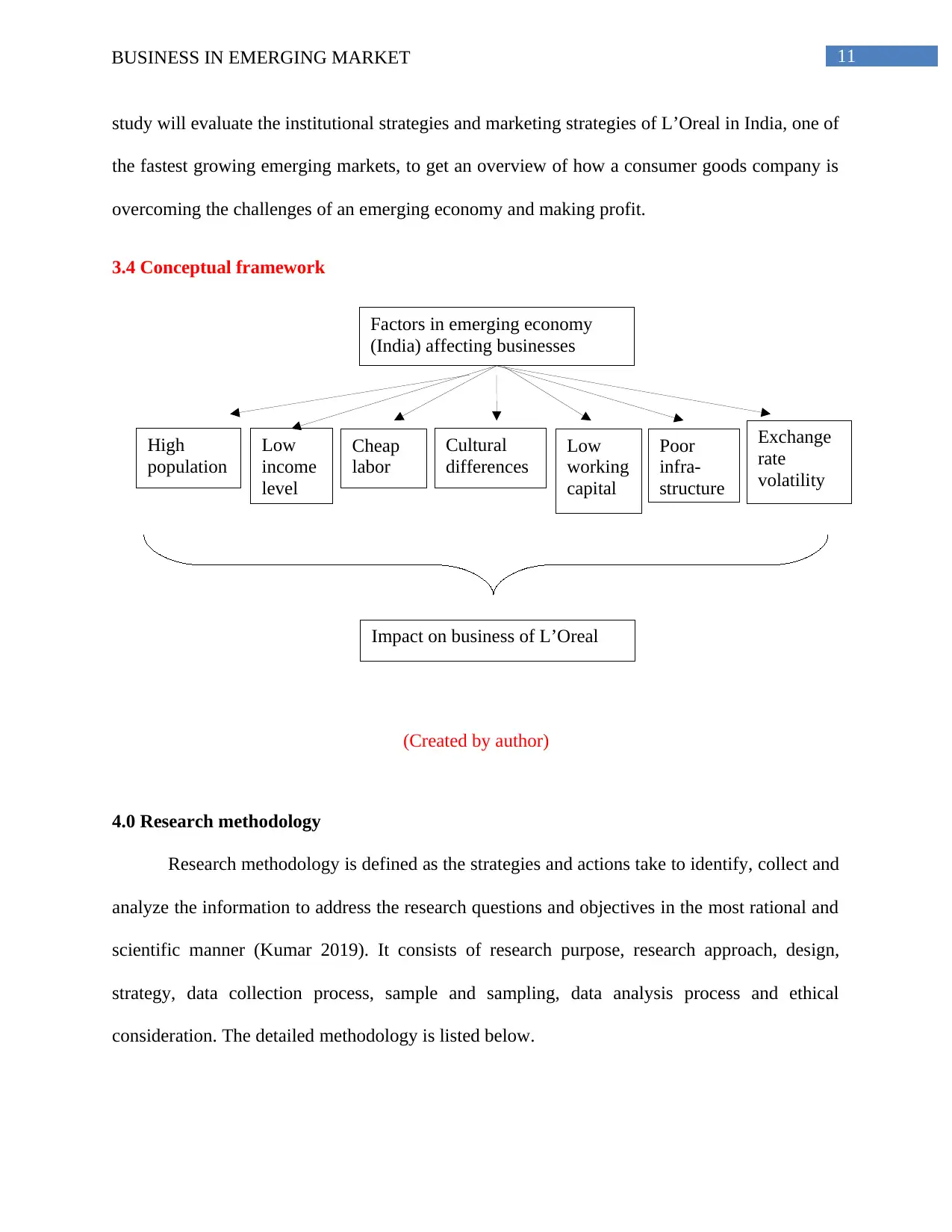
11BUSINESS IN EMERGING MARKET
Factors in emerging economy
(India) affecting businesses
High
population
Low
income
level
Cultural
differences
Exchange
rate
volatility
Low
working
capital
Poor
infra-
structure
Cheap
labor
Impact on business of L’Oreal
study will evaluate the institutional strategies and marketing strategies of L’Oreal in India, one of
the fastest growing emerging markets, to get an overview of how a consumer goods company is
overcoming the challenges of an emerging economy and making profit.
3.4 Conceptual framework
(Created by author)
4.0 Research methodology
Research methodology is defined as the strategies and actions take to identify, collect and
analyze the information to address the research questions and objectives in the most rational and
scientific manner (Kumar 2019). It consists of research purpose, research approach, design,
strategy, data collection process, sample and sampling, data analysis process and ethical
consideration. The detailed methodology is listed below.
Factors in emerging economy
(India) affecting businesses
High
population
Low
income
level
Cultural
differences
Exchange
rate
volatility
Low
working
capital
Poor
infra-
structure
Cheap
labor
Impact on business of L’Oreal
study will evaluate the institutional strategies and marketing strategies of L’Oreal in India, one of
the fastest growing emerging markets, to get an overview of how a consumer goods company is
overcoming the challenges of an emerging economy and making profit.
3.4 Conceptual framework
(Created by author)
4.0 Research methodology
Research methodology is defined as the strategies and actions take to identify, collect and
analyze the information to address the research questions and objectives in the most rational and
scientific manner (Kumar 2019). It consists of research purpose, research approach, design,
strategy, data collection process, sample and sampling, data analysis process and ethical
consideration. The detailed methodology is listed below.
⊘ This is a preview!⊘
Do you want full access?
Subscribe today to unlock all pages.

Trusted by 1+ million students worldwide
1 out of 21
Related Documents
Your All-in-One AI-Powered Toolkit for Academic Success.
+13062052269
info@desklib.com
Available 24*7 on WhatsApp / Email
![[object Object]](/_next/static/media/star-bottom.7253800d.svg)
Unlock your academic potential
Copyright © 2020–2025 A2Z Services. All Rights Reserved. Developed and managed by ZUCOL.




